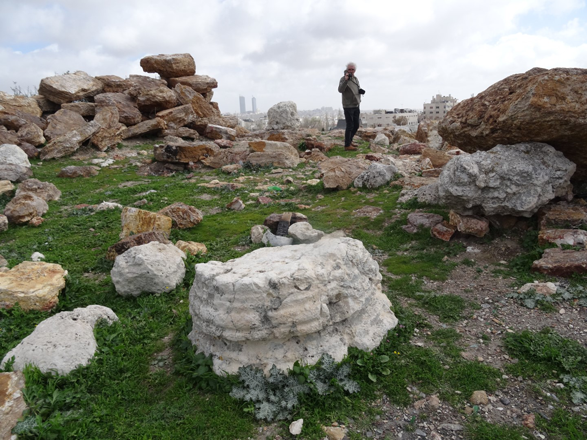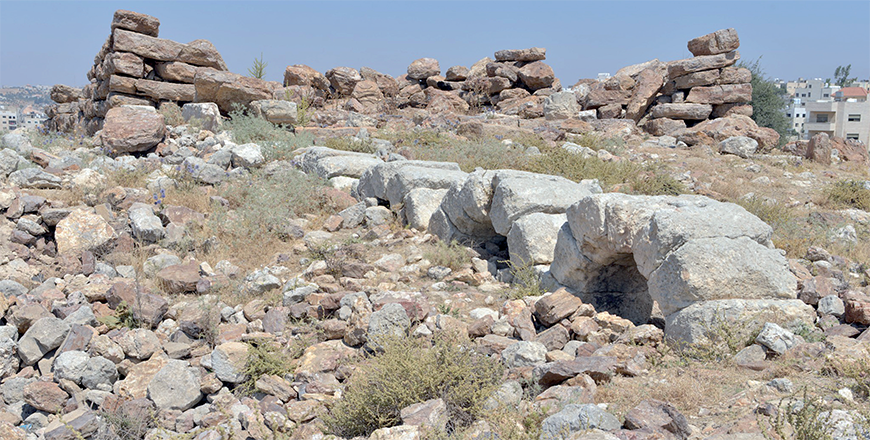You are here
New insights to Ammonite, Roman Beliefs from Khirbet es-Sar’s tower temple
By Saeb Rawashdeh - Nov 16,2024 - Last updated at Nov 16,2024

Khirbet es Sar is a site from the Iron Age near Bayader Wadi Sir (Photo of Mariusz Burdajewicz)
AMMAN — A few years ago, before the outbreak of the COVID pandemic, the archaeological team from Polish Centre of the Mediterranean Archaeology, University of Warsaw, conducted two seasons of fieldwork at Khirbat es-Sar in western outskirts of Amman.
The aim of the research in 2018 and 2019 was to understand the nature and chronology of that spectacular site which, occupying an excellent strategic position, was topped with a monumental architectural complex.
“‘Ammonite tower’ re-used in the Roman Period as a temple and an arcaded courtyard added to it, this compound is surrounded by unspecified walls apparently of later periods,” noted the professor Mariusz Burdajewicz, adding that in 2018, a reconnaissance survey was conducted within the area fenced by the Department of Antiquities, during which a preliminary plan of the site was worked out.
"Earthen floors demonstrated that the site was densely inhabited, and the Roman structures were extensively re-used starting from the Abbasid times, but especially in the Ayyubid-Mamluk period," Burdajewicz said, noting that no Byzantine to Umayyad-period architectural remains have been identified, which requires further investigation in the area.
The results of the preliminary fieldwork at Khirbat as-Sar have confirmed the considerable scientific potential of the site.
Furthermore, in 2022, a new research project of the Faculty of Archaeology, University of Warsaw, has been launched financed by the National Science Centre and that project addresses the dynamics of the relationship of the hinterland/periphery with the city/town in Central Transjordan.
"It is based on investigations at Khirbat es-Sar against the background of historical and cultural development of Amman, covering the period from the Ammonite Iron Age to the Middle Islamic period [c. 8th century BC - 14th century AD]. Among several research objectives, two issues will be crucial to understanding the nature of the site," Burdajewicz noted.
The Iron Age II period: a much-debated issue concerning tower structures (some of them square and some round) built around Amman and so characteristic of its periphery landscape.
Archaeologists speculated about the function of the structures at Khirbet es Sara, whether there were watchtowers, storage or housing for the local community.
"Possibly the towers were not military structures built and operated by the state but constructed by local communities to protect agricultural installations from nomadic raids. It is also questionable who built the towers: either the Ammonites, which may seem obvious, or the Assyrians during their imperial expansion to the south," Burdajewicz stressed.
During the Greco-Roman Period, the tower was adapted for a temple with the classical Vitruvian order (fragments of Ionic column bases still preserved in the vestibule) and an arcaded courtyard was added to it in the Roman times, c. 3rd century AD. At that time, the site was probably an important religious centre, whose monumental character indicates prominence beyond just local.
Nevertheless, the possible connections to religious cults in the capital itself remain to be determined.
"It is obvious that the future study of the sacred complex at Khirbat es-Sar should be placed in a wider perspective of the process of Hellenisation and Romanisation of indigenous cults in the Graeco Roman East. This issue, common to other cities of Decapolis, still needs investigation and clarification. Numismatic, epigraphic, and, to a lesser extent, archaeological sources provide information about the religious life in Philadelphia," Burdajewicz underlined, adding that among the most popular deities worshipped in the city, the following should be mentioned: Zeus Ammon, Heracles, Tyche, Demeter, Athena, Aphrodite, Dionysos, Hermes, Harpokrates.
Further research may determine whether any of these deities, or some others, were worshipped in Khirbat es-Sar. It remains undetermined but most of temples were on Amman Citadel.
One of them is the temple of Heracles, also an altar or temple dedicated to the Ammonite god Milkom.
"In the chora of Philadelphia at least two extra-muros temples/ sanctuaries have been localised. One is attested only by the epigraphical evidence from Ragib, ca. 12km southeast from the Amman Citadel. An inscription found in the city necropolis refers to the sanctuary of Zeus and Demeter [Astarte]. The other temple is known from the ruins at Khirbat Suq, 14 km south of the centre of Amman," Burdajewicz underlined, adding that the temple consists of cella, vestibule and a courtyard, probably surrounded by a wall.
The columns are topped with Ionian capitals, the professor said.
“The case of the tower temple at Khirbat es-Sar seems to be particularly promising and offers a chance of gaining new and essential information regarding the religious life in Philadelphia,” Burdajewicz said, adding that this is because this hybrid structure presents a unique combination of the native architecture rooted in the Iron Age with elements of classical Greco-Roman temples.
"An extremely important task is also to determine the structural and, above all, functional relationship between the tower temple and the chronologically later arcaded courtyard in front of it," Burdajewicz concluded.
Related Articles
AMMAN — Khirbat as-Sar is 972m above sea level on the western end of the plateau, commanding access to Rabbat Ammon/Philadelphia (Amman of t
AMMAN — Some archeological sites are inside the most urban areas of Amman, while others are located on its outskirts.
AMMAN — The Polish archaeological team recently dug at Khirbet as-Sar, a site in Bayader Wadi Sir, on the western outskirts of Amman.


















